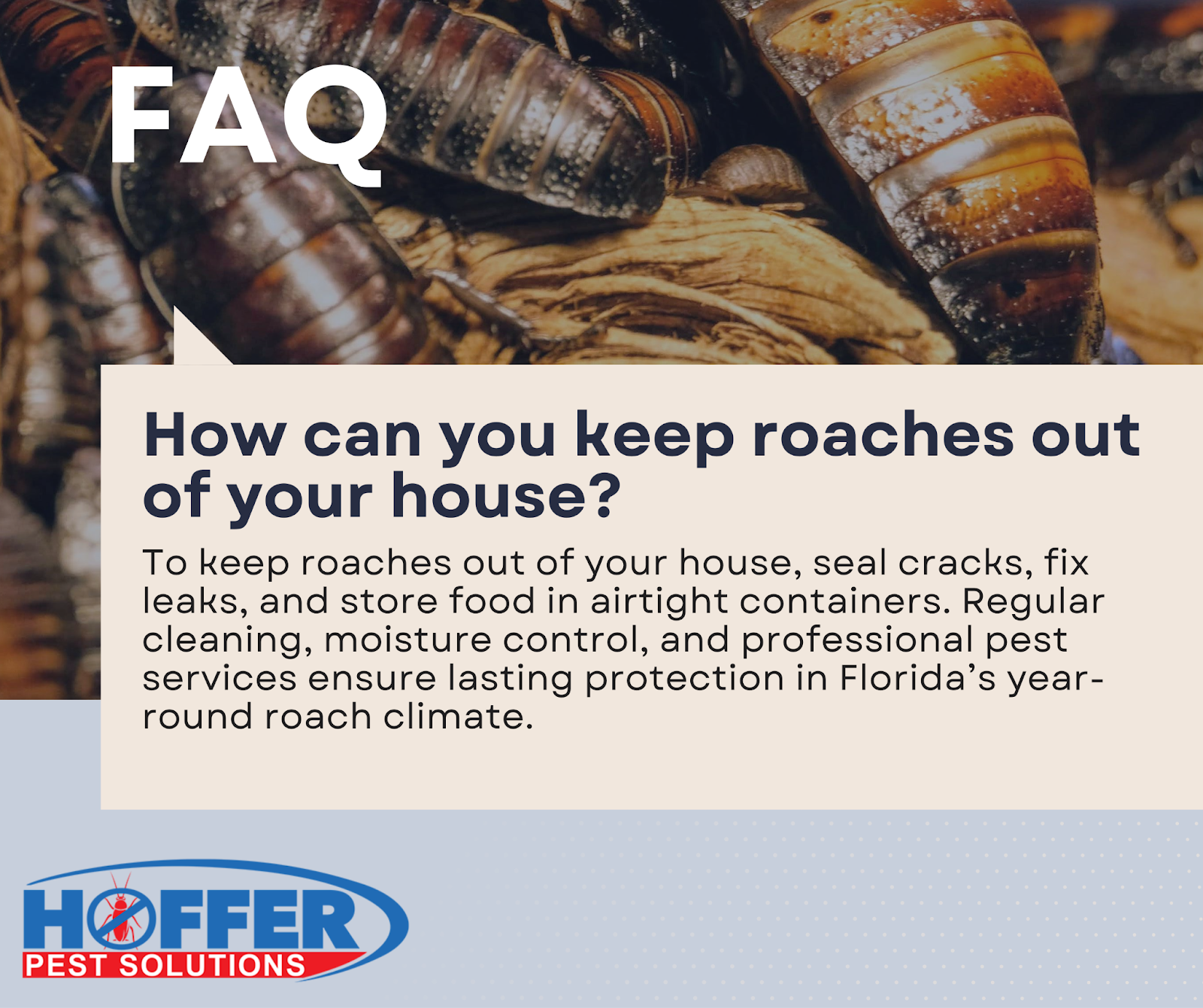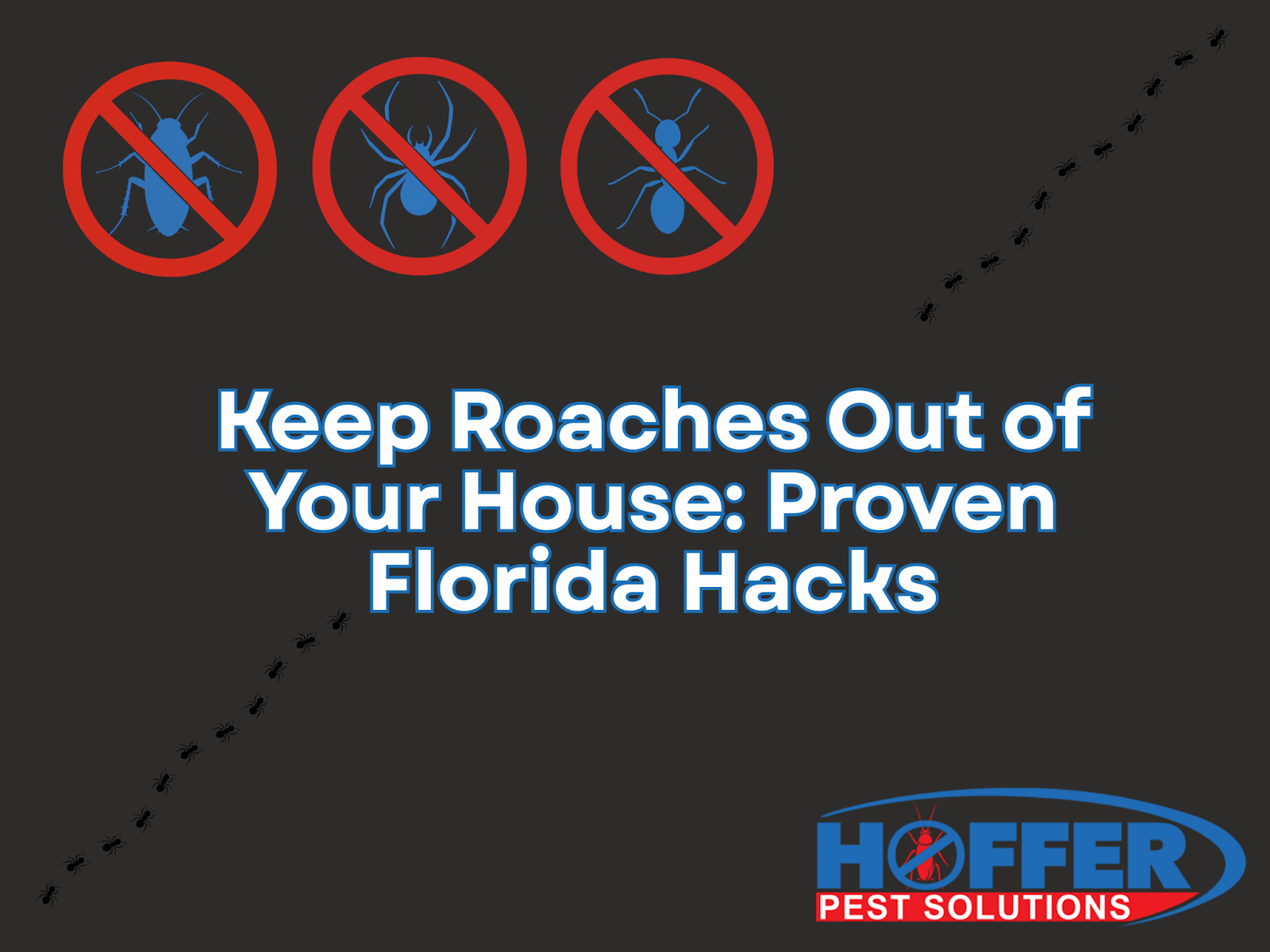To keep roaches out of your house, seal cracks, fix leaks, and store food in airtight containers. Regular cleaning, moisture control, and professional pest services ensure lasting protection in Florida’s year-round roach climate.

![]()
Florida’s warm, humid weather makes roaches a constant challenge. They sneak inside through cracks, drains, and even cardboard boxes, quickly turning a small problem into a full-blown infestation. Protecting your home starts with consistent prevention: cut off food and water, block entry points, and monitor for signs before they spread.
Hoffer Pest Solutions has spent more than 40 years helping South Florida families stay roach-free with safe, eco-friendly treatments and same-day service when needed. If you’re ready to keep your home protected for good, we can help.
Below, we’ll walk through a clear, step-by-step plan, everything from food storage to outdoor maintenance, so you know exactly how to keep roaches out of your house.
Step-by-Step Guide to Keeping Roaches Out of Your House
![]()
Roaches are a constant challenge in Florida’s warm, humid climate. The good news is you don’t need to live with them. By following a clear, step-by-step process, starting with food and water elimination and ending with professional protection, you can keep your home roach-free year-round.
Step 1: Eliminate Food Sources
Roaches are opportunistic eaters, and even the tiniest crumb can keep them thriving. Prevention begins in the kitchen:
Store pantry staples like rice, flour, and cereal in airtight containers.
Wipe grease and crumbs off counters and stovetops daily.
Wash dirty dishes promptly, especially before bedtime.
Rinse recyclables like soda cans and jars to remove sugary residues.
Don’t leave pet food out overnight, offer it at mealtimes and remove the bowl when your pet is done.
What surprises many homeowners is how broad roaches’ diet really is. They don’t just go after food scraps, cardboard, glue, and paper are also attractive. That’s why decluttering storage areas and avoiding long-term cardboard storage is necessary. Using plastic bins instead reduces both food sources and hiding places.
Step 2: Cut Off Water and Shelter
If food is limited, roaches can survive. But without water, they die within a week. That’s why moisture control is just as critical as cleaning.
Repair leaky faucets, sweating pipes, or drips under sinks.
Wipe sinks, counters, and stovetops dry before going to bed.
Empty pet water dishes overnight.
Manage humidity with air conditioning or dehumidifiers, particularly in bathrooms, basements, or laundry rooms.
Roaches are also masters of hiding. They squeeze behind stoves, inside cardboard piles, and beneath appliances. Reducing clutter limits their options and makes your preventive steps more effective.
In Florida, irrigation overspray and water pooling near foundations create micro-oases for outdoor roaches. Drying these areas helps keep them from migrating indoors in the first place.
Step 3: Seal Entry Points Around the Home
Even with perfect sanitation, roaches will come inside if they find a path. Inspect your home regularly for cracks and gaps:
Caulk around plumbing penetrations, utility lines, and trim.
Install and maintain tight-fitting door sweeps. Even small gaps can be a “highway” for roaches.
Repair torn screens on windows, doors, and vents.
Keep firewood, mulch, and landscaping a few feet from the foundation to reduce exterior pressure.
Some homeowners wonder, “Do roaches really come up through drains?”
The answer is yes, especially American roaches from sewers. Simple drain covers or stoppers can stop them from using pipes as entry points.
Routine inspection is just as significant as the first round of sealing. Weather stripping wears down, screens tear, and small cracks reopen over time. Setting a reminder to check quarterly keeps your defenses strong. If you need help, make sure to contact Hoffer Pest Solutions.
Step 4: DIY Prevention Tools That Work
![]()
For homeowners tackling roaches on their own, there are a handful of tools that can make a difference when applied correctly.
Diatomaceous earth (DE): Food-grade DE dehydrates roaches when they crawl through it. The key is applying a thin, barely visible dusting along travel paths, too much, and roaches will simply avoid it.
Boric acid: A proven roach killer, but it only works in ultra-light films where roaches groom it off their legs. A DIY trick many homeowners use is loading boric acid into a squeeze bottle with a few coins; this helps shake out an even dust layer in tight spaces.
Baking soda bait: When mixed with sugar, it attracts roaches and causes internal damage after they ingest it. While slower than boric acid, it can supplement other methods.
Sticky traps: These help monitor activity and pinpoint hot spots, but they won’t eliminate infestations on their own.
What about ultrasonic repellents that claim to drive roaches out with sound? Studies show they aren’t effective. Focus your DIY efforts on proven tools instead.
Some homeowners try dusting behind outlet covers or around stoves, but this must be done cautiously. Avoid overapplying near electrical areas, and never place powders directly where food is prepared.
Step 5: When DIY Isn’t Enough
DIY measures can reduce roach pressure, but they don’t always solve the root of the problem. Signs that professional help is needed include:
Roaches visible in daylight.
A musty odor lingering in kitchens or bathrooms.
Egg cases or shed skins appearing in cabinets.
Recurring sightings even after thorough cleaning.
Hoffer Pest Solutions offers what DIY can’t: targeted inspections, eco-friendly treatments, and access to professional-grade products that eliminate roaches at the source. With same-day availability when you call before noon, we help homeowners in South Florida reclaim their space quickly and discreetly. Need help? Call us today for a free inspection.
Step 6: Manage Outdoor Factors
![]()
Keeping roaches away starts outside. Many infestations begin when outdoor populations grow near your home’s foundation.
Trim trees and shrubs: Roaches can climb branches that touch siding or rooflines, creating easy access to attics and upper floors.
Relocate bird feeders: Spilled seed feeds roaches and they will happily gather at the base. Moving feeders farther from the house reduces pressure.
Clean outdoor grills: Leftover grease and crumbs on patios or decks can sustain roach populations that later move indoors.
Reduce water sources: Irrigation overspray, clogged gutters, and plant saucers all create damp spots where roaches thrive.
Step 7: Monitor and Maintain Preventive Measures
Prevention is about consistency.
Sticky traps: Use them for catching roaches and for monitoring. They reveal which areas are most active, guiding where to focus treatments.
Inspect seals regularly: Door sweeps wear out, and weather stripping shifts over time. Small gaps may look harmless but are often big enough for roaches.
Rotate products: Using the same bait or gel repeatedly can lead to resistance. Switching active ingredients keeps treatments effective.
Vacuum and wipe frequently: Especially under appliances, where pheromone trails signal safe harborage to other roaches.
Step 8: Safeguard Against Hitchhiking Roaches
Not every infestation starts outside, sometimes roaches are carried in.
Inspect deliveries and groceries: German roaches are notorious for hitchhiking in boxes and bags.
Check secondhand furniture or appliances: These items may conceal egg cases or nymphs.
Avoid cardboard storage: Roaches chew on cardboard and glue. Use plastic bins for long-term storage in garages or closets.
Multi-family living: In apartments or condos, infestations spread through walls, plumbing lines, and hallways. Coordinated pest control is often necessary to stop them.
Understanding the Enemy: Roach Behavior and Types
![]()
Not all roaches behave the same way, and knowing what species you’re dealing with can change your strategy.
German roaches
The most common indoor problem. Small, tan, and fast-breeding, they thrive in warm kitchens and bathrooms. A single egg case can contain dozens of nymphs, meaning infestations explode quickly.
American roaches
Often called palmetto bugs here in Florida, are large and reddish-brown. They often live outdoors in sewers or landscaping but will wander indoors through drains or cracks.
Smokybrown and Oriental roaches
Prefer damp, cooler environments. Smokybrowns, in particular, travel from trees into attics or rooflines, one reason trimming back branches matters.
Knowing which roach you’re dealing with helps you pick the right mix of sanitation, exclusion, and treatments. Our inspections always start with species identification so we can customize the plan.
Helpful Resource -> Cockroach Season Florida: When It Starts & How to Stop It
Why Work With Hoffer Pest Solutions
![]()
As a second-generation, family-owned company, we live in the same South Florida communities we serve. For more than 40 years, our mission has been simple: deliver peace of mind through world-class service.
Local expertise: We understand how Florida’s humidity and year-round warmth create unique pest pressures.
Trusted service: Call before noon, and we offer same-day appointments.
Comprehensive protection: Our Home Shield Advantage plan covers roaches, ants, termites, rodents, and more with guaranteed results.
Community roots: Beyond pest control, our team supports causes like Habitat for Humanity and local school events.
Unlike national chains, we’re neighbors who care deeply about keeping your home safe, clean, and pest-free.
Overall Takeaway
Roaches thrive in Florida’s climate, and even spotless homes can be at risk. Eliminating food, water, and entry points helps, but lasting protection often requires professional care.
Hoffer Pest Solutions has kept South Florida homes pest-free for over 40 years with eco-friendly treatments, guaranteed results, and same-day service. Call Hoffer Pest Solutions today and reclaim your home from roaches.
Frequently Asked Questions (FAQ)
What’s the safest way to apply boric acid at home?
Apply a thin, almost invisible layer using a squeeze bottle or applicator. Keep it in cracks and crevices where pets and children cannot reach. Avoid dusting directly on counters, stoves, or food prep areas.
Can peanut butter and borax really work as bait?
Yes, peanut butter can attract roaches and borax can harm them, but this mixture is less consistent than professional baits. For safer and faster results, gel baits are usually the better choice.
Is vinegar or bleach useful for keeping roaches away?
Vinegar and bleach help remove grease and food films, which reduces what attracts roaches. However, they don’t kill or repel roaches directly. Think of them as cleaning tools, not pest control solutions.
What’s better for homes with pets, gel baits or diatomaceous earth (DE)?
Both can work, but gel baits are often safer indoors because they can be applied in small, contained spots. DE is only safe if it’s kept where pets won’t disturb it, such as inside wall voids or behind appliances.
How much boric acid or DE is too much?
Less is more. A light dusting works best because roaches need to crawl through it. If you can see thick piles, it’s overapplied, roaches will avoid it, and it may create unnecessary mess or irritation.


